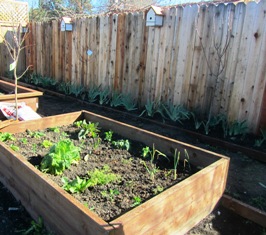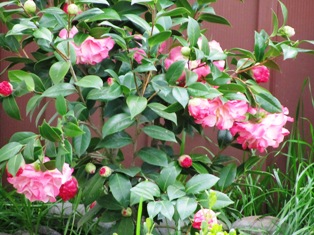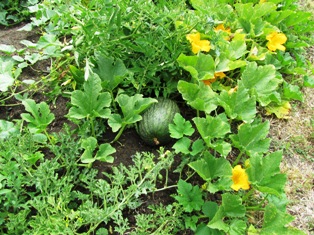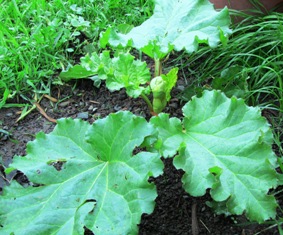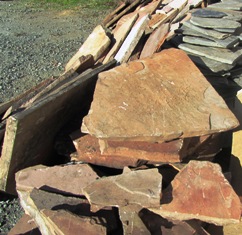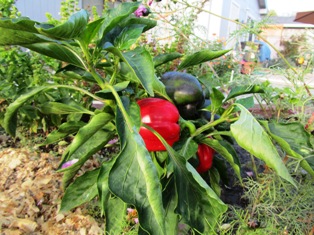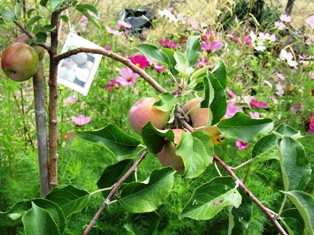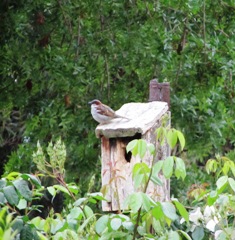Archive for January, 2013
Plants for a Songbird Garden
If you enjoy songbirds as I do, you might want to plant a garden of flower and herb varieties to attract them.
Include in your songbird garden some perennials and annual plants. The perennials will re-seed themselves or return year after year. Commercial seed companies offer a pre-packaged collection of seeds, but you can also gather your seeds or plants from other sources such as friends, neighbors, and garden club members. I save the seed from many of my plants, dry them, and use them for planting the next year.
Plants might include (but are not limited to) Alcea rosea (common hollyhock, comes in many colors), Amaranthus caudatus (commonly known as love-lies-bleeding), Carthamus tinctoria (safflower seed), coreopsis (tickseed), Cosmos bipinnatas (old flower garden favorite), Delphinium ajacus (blue or purple larkspur), Echinacea purpurea (eastern purple coneflower), Eschscholzia California (California poppy), Guizotia abyssinica (Nyjer seed, often called thistle although it isn’t thistle by an oily seed loved by finches), Panicum miliaceum (common millet), Papaver rhoeas (opium poppy, some types can be as tall as seven feet), and Rudbeckia hirta (Black-eyed Susan).
The heights of these various plants range from about 15 inches to six or seven feet. The colors are varied, ranging from whites to pink, red, orange, yellow, green, and blue.
The types of songbirds these plants will attract include cardinals, finches, goldfinches, hummingbirds, mockingbirds, warblers, chickadees, wrens, titmice, and thrushes.
The Cornell Baking Soda Formula for Roses
While perusing the December 2012 edition of American Rose, the Magazine of the American Rose Society, I discovered an article about the diseases of roses and some of the ways several rose experts would deal with them.
In a discussion of treating rust, downey mildew, and blackspot, the rose experts concurred that prevention is the first line of defense against these diseases. Once you find evidence of them in your garden, you must remove and destroy infected leaves and stems, including the leaves that have fallen to the ground.
Another important step, among others, was to spray an oil and bicarbonate of soda recipe referred to as the Cornell Baking Soda Formula.
The ingredients are simple and can be found in many homes: 1 Tablespoon each of baking soda, horticultural or summer oil, and castille soap. Mix these into 1 gallon of water, shake, and spray.
For advice on growing roses that are best suited to your area, check with your local nurseries and consider joining your the American rose society or local garden club. Also, think about choosing varieties of roses to grow in your area that are resistant to these diseases.
Keeping a Garden Ecosystem in Balance
A healthy ecosystem, whether in a forest or a garden, stays in balance in part because of its “grazers” and “predators.” The grazers can range in size from a large plant-eating animal like a cow to a tiny aphid, and predators share this size range, too. Consider for example, a tiger (predator) in a wild, natural environment dining on an antelope (a grazer) or tiny ladybug (a predator for grazing aphids) in a rose garden.
A lush, healthy garden will have an underlying healthy ecosystem. If your garden plants are being devoured by pests, you might want to introduce more of the pests’ natural enemies. For example, if your roses are infested with one or more of the 200 different types of aphids, buy lacewings.
One lacewing larva can destroy roughly 200 pests (and pest eggs) for as long as two or three weeks. The adult lacewings do not kill insects (they suck nectar and pollen), but their larvae will inject venom into aphids and then suck out the the plant grazers’ body fluids, which destroys those pests. Adult lacewings will stick around if there are sources of pollen, nectar, and honeydew. They are beneficial to a garden ecosystem because the lacewing larvae feed on spider mites, mealybugs, leafhoppers, thripes, and other unwanted plant grazers.
Take a stroll around your garden on a regular basis. Take note of its ecosystem. Create a healthy garden using organic products when possible. Remember that plants cycle through seasons. There may be periods of the year when your plants seem to be more infested than at other times. Practice tolerance if an infestation is mild. Let nature run its course. If the balance is right in your ecosystem, the predators will take care of the grazers.
Organic Amendments to Benefit Soil
There are many ways to improve soil composition to grow healthy plants. Healthy plants produce more abundant and bigger yields.
The soil on the Henny Penny Farmette is mostly heavy clay. After a rain, its sticks together like solid, cold mass of margarine. In the summer, it hardens like concrete and also cracks.
To make soil more porous, it is necessary to add amendments that permit air circulation and water penetration and retention.
There are basically two different types of amendments. The mineral amendments such as vermiculite, pumice, and perlite are generally used in sandy soil to create aeration and water retention. Types of organic amendments for soil such as our clay soil include manure, leaf mold, ground bark, peat moss, and sawdust. These rely on bacterial action to break down into a soft, crumbly humus.
In our vegetable growing boxes that are 4 feet by 6 feet, we include 25 percent organic amendments to 75 percent soil. Sometimes we even up the percentage of amendment material. We turn it thoroughly.
The clay soil immediately benefits from the tilling (adding air) and also from the blending of organic material into the soil to change its density, nutrient value, and permeability to water.
Raised beds, which I first saw on farms in villages along the Volga in Russia, allow us to control the soil and makes it easier to add amendments and mulch. However, we also have garden beds, too, that benefit from organic amendments.
Planning and Planting a Perfumed White Garden
Some years ago while researching a book about decorating with flowers and floral motifs, I learned about the white garden of English writer Vita Sackville-West. The garden was part of her Sissinghurst estate in Kent, England. I seized upon the idea of someday having my own white garden.
Sackville-West’s garden, planted roughly from 1949 to 1950 featured various plants with white flowers and others with gray-green foliage. The combination of white and gray-green colors is stunning when viewed by moonlight. The author sought not only ravishing florals such as Regale lilies and trumpet lilies, dianthus, and white peonies but also made certain that her chosen flowers would perfume the garden.
On my Henny Penny farmette, I’ve created a fairy ring in a white garden that I’ve started. The center of the fairy ring is an Iceberg hybrid tea rose. I used artemisia (Dusty Miller) with silvery gray-green leaves planted in a circle around the rose. I frequently have to aggressively clip the artemisia as its feathery leaves grow fairly fast.
In another area, I have also planted a group of floribunda white roses and plan to put in white mugwort. Other plants with white blooms will be added and then the whole area encircled in yarrow. A piece of statuary, perhaps a four or five foot angel, will be installed to finish the project.
Other white flowering plants I could tuck into a white garden could include tuberose, phlox, Madonna lily, evening stock, cleome, and various white roses. Those plants are also highly fragrant.
A perfect place to position a white perfumed garden might be beyond a bedroom window. You could see it in the moonlight and breathe in the heady perfume as you are falling asleep.
Late January Garden Chores
With spring only two months away, there is still plenty of work to be done in Northern California gardens. The following is my list of things to do on the Henny Penny Farmette.
Apply iron sulfate to acid-lovers
Camellias belong to a group of plants that thrive in soil with a pH balance that is acidic. Examples of a some other acid-loving plants include azaleas, begonias, caladiums, gardenias, hydrangeas, impatiens, Japanese maples, jasmine, and primulas, to name a few.
This time of year I give these plants an application of iron sulfate to maintain the plant’s green color. My blueberry bushes and citrus trees also benefit from receiving an application of iron sulfate or the non-staining Iron Plus.
Build or purchase compost bins and raised-bed earth boxes
Every garden needs compost and bins make it easy to produce that nutrient rich material that plants love. This is the time to build or buy compost bins and also the raised bed boxes. We’ve put in eight and have plans to build more.
Prune fruit trees
Prune fruit trees for shape and also to produce fruit. For example, I cut back the peaches and nectarines by about 2/3 of last year’s growth. The new growth bears only once. Hence, the need for vigorous pruning. I cut back the apricots by about 1/3 of last year’s growth, paying special attention to any spurs (usually productive for three to five years). Branches with spurs that age will have to be replaced by cutting them away so the tree can produce new branches with fruiting spurs.
Fruit and nut trees that require very little pruning (mostly to eliminate dead wood or crossing branches) include cherries, apples, pears, and almonds. I tend to cut away small branches of the almonds. The nuts will be born on new spurs and shoots.
Apply dormant oil to roses
Roses, once they’ve been pruned, need an application of dormant oil such as Bonide All Seasons Spray Oil (for organic gardens). The oil is beneficial for eliminating over-wintering pest populations by smothering the pests’ eggs. To halt fungus-precipitated diseases like rust, blackspot, and powdery mildrew, spray roses with liquid copper.
Dress the lawn with a winter fertilizer
Feed the lawn with a good quality lawn fertilizer to keep it green, growing, and resistant to rust and diseases arising from malnutrition.
Spray liquid copper to curb Peach Leaf Curl
An application of liquid copper keeps peaches and nectarine trees resistant to the disfiguring curling of new leaf growth.
I know that the work I do now in the garden will pay big dividends when warm weather arrives and the chores of planting and tending vegetables begins. The above list is my garden chores checklist for this time of year. Feel free to use it to build a checklist for your garden.
Seasonal and Perennial Vegetables
To get your vegetable garden off to a great start, know whether you are planting a cool season- or warm-season plant. Get your veggies into the soil at the right time for optimum results. For warm–season vegetables such as beans, corn, cucumber, eggplant, melons, peppers, squash, and tomatoes, plant as soon as the soil is workable, when frost danger has passed.
Sow seeds directly into the soil or plant seedlings that you’ve started in flats indoors or that you buy at the nursery. The warm-season vegetables will grow and crops often will be ready to harvest before the blazing heat of mid-summer sets in.
Cool-season plants include asparagus, broad bean, beet, broccoli, brussels sprouts, cabbage, carrot, cauliflower, endive, garlic, leek, lettuce, parsnip, pea, radish, and turnip. These can go into the earth mid-summer so the growth spurt to maturation takes place during the fall. Crops can be harvested in the autumn or early spring.
Most vegetable are annuals, but a few are perennial plants, including artichoke, asparagus, chayote, and rhubarb.
Rhubarb is a vegetable, but is often used like a fruit (for example, with strawberries) in a sauce or pie. Plant rhubarb in early spring or late winter. Don’t plan on harvesting stalks until the third spring (giving the plant two complete growing cycles). When harvesting, discard the leaves as they are poisonous.
Asparagus is another plant that needs about three growing cycles, but then will reward with spears for a dozen or more years in the garden. The green feathery top growth is a lovely but when it turns brown in the fall, it needs to be cut to soil level.
Artichokes need a lot of garden space as they grow to about 4 feet high and can double that size in width. Artichokes grown in coastal California, are harvested from September to May. They are the flower buds found at the top of large stalks. The perennial artichoke will need to have the tops cut to about a foot in the fall and folded over the top of the root. The plant then needs heavy mulching to protect it during cold weather.
Chayote is a relative of squash and produces edible fruits along a climbing vine. Plant this perennial in February or March (after the frost danger has passed) near a fence or on a trellis. When you tuck this plant into your garden, be sure to put the sprouted end at the lowest level in the soil, leaving the narrow end exposed. Expect 20 to 30 feet or more of vine.
Before you head off to the nursery to buy plants, consider starting some seeds indoors. Not only will you find it to be economical, you’ll also get a jump on the growing season.
Grow plants from open-pollinated seed. You can then harvest some of the seeds to use again next year. Hybridized seed won’t come true the second year, but open-pollinated seeds will produce plants just like the parent plant.
Recycling Landscape Materials
My ears perk up when I hear someone talking about renovating his or her landscape since such a project often involves removing not only plants but potentially brick, flagstone, and other types of outdoor flooring and landscaping materials.
After learning about a demolition going on down the road recently, we inquired whether or not we could haul away the unwanted stone. The property’s owners had already begun the tear-out as a first step in revamping the home’s entire landscape. Out came decades-old rose bushes and two types of stone, some of it slate.
Flagstone, redstone pavers, and boulders can be reused to create raised beds for flowers, herbs, or vegetables. A caveat about using natural stone or boulders: keep them low as soil can sift out between the cracks unless you use mortar. Better still, use landscape fabric as a barrier against the soil sifting.
In our arrangement, the homeowner will not need to pay someone to haul away unwanted materials. We will not have to pay for the stone. We can stack it on our property and when we are ready, use it to construct an outdoor kitchen floor or sitting area. Most importantly, we are recycling, keeping the unwanted landscape materials out of landfill.
Potager Gardens
Growing up on a farm in rural Missouri, I learned early in life that the quality of food is the direct result of the quality of the garden in which the vegetables and fruits are grown. The culinary creations on the table of my childhood tasted best when the vegetables were freshly plucked from my grandmother’s garden.
After college, I moved to Northern California on a ten-acre ranch planted in grapes atop the Santa Cruz Mountains. There, I created a small kitchen garden using French intensive gardening methods. I hoped to have vegetables like we grew in Missouri and was pleasantly surprised when the quantity and size of my California-grown vegetables exceeded those on my grandmother’s Missouri farm.
I fell in love with the idea of potager gardens after reading about the culinary traditions of the French and the abundance of herbs and vegetables, berry vines, fruit trees, and flowers they grew in square and rectangular shapes sectioned off in their gardens. Those French potager gardens were not only functional, but visually stunning, ever-changing, living works of art.
Throughout history, the gardeners of large French châteaux would create elaborate potagers with parterres that gave them a formal aesthetic. Along with tightly-clipped hedges of boxwood, fencing, or stone, the gardens might include ornamental plants and water features such as fountains or stone troughs.
A simple design for a modern country potager in an urban or rural landscape could be laid out as a cross within a square. At its center (in the heart of the garden), one could install a fountain, a piece of statuary, pot of flowers that provide riotous color or fragrance, bird bath, or piece of exotic garden art.
In my garden, we are deviating from a conventional formal design. Working along the perimeter of our rectangular-shaped property, we have laid out double rows. Along the back row, we have planted fruit trees. Along the second row (in front of the back row), we have built boxes (4 feet by 6 feet) leaving the same size of space between the boxes. We have planted berries, flowers, or vegetables in each box; in the spaces between the boxes, we’ve planted fruit trees.
The boxes are basically raised beds in which we can control the soil type. Otherwise, we find it difficult to work the soil here in this inland valley, east of the San Francisco Bay, because it is composed of clay and becomes as hard as concrete in the summer. We’ve found that root crops, such as potatoes, carrots, and turnips are difficult to grow in such compacted, clay soil.
I may not have a spectacular potager of the type you might find on a French country estate, but the organic heirloom vegetables and fruits taste terrific and that is a testament to the quality of the garden, I believe.
Is He or Isn’t He a Brown-headed Nuthatch?
I’ve been checking out the photos of birds I’ve taken since moving to the Henny Penny Farmette. I’ve been able to identify most of them, but one took a while for me to figure out. Like other birds that come by for a visit, he perched for a spell atop the rough-hewn birdhouse on the back fence. I think he is a brown-headed nuthatch (sitta pusilla), although I am not completely convinced I’m right. Half the fun of being a bird watcher is figuring out what species you have spotted.
Still, the bird has the right markings–the brown cap down to the eye, white nape spot, white throat and underparts, and some gray on its back. With beady eyes, broad shoulders, and a short neck, this little bird seems to best fit the description of the brown-headed nuthatch although that species likes the pine forests of the southern United States and travels in flocks. This fellow showed up alone in my Northern California garden.
I got out my Audubon Society bird guidebook and the Song and Garden Birds of North America, a National Geographic book, to help me identify the nuthatch and some of our other feathered friends. So far, we’ve had visits by sparrows, finches, scrub jays, a pair of Western bluebirds, mourning doves, wrens, a barn owl, lots of hawks and crows, and hummingbirds.
We’ve put up birdhouses, some with rough bark exteriors, that seem to attract certain types of birds. Other birdhouses are smooth surfaced. The bluebirds were checking out one of those today. Spring will come . . . eventually, but even before trees start to break bud, the birds will be scouting nesting sites. I’m hoping the brown-headed nuthatch will return with a mate and stay around for a while.
 Facebook
Facebook Goodreads
Goodreads LinkedIn
LinkedIn Meera Lester
Meera Lester Twitter
Twitter








